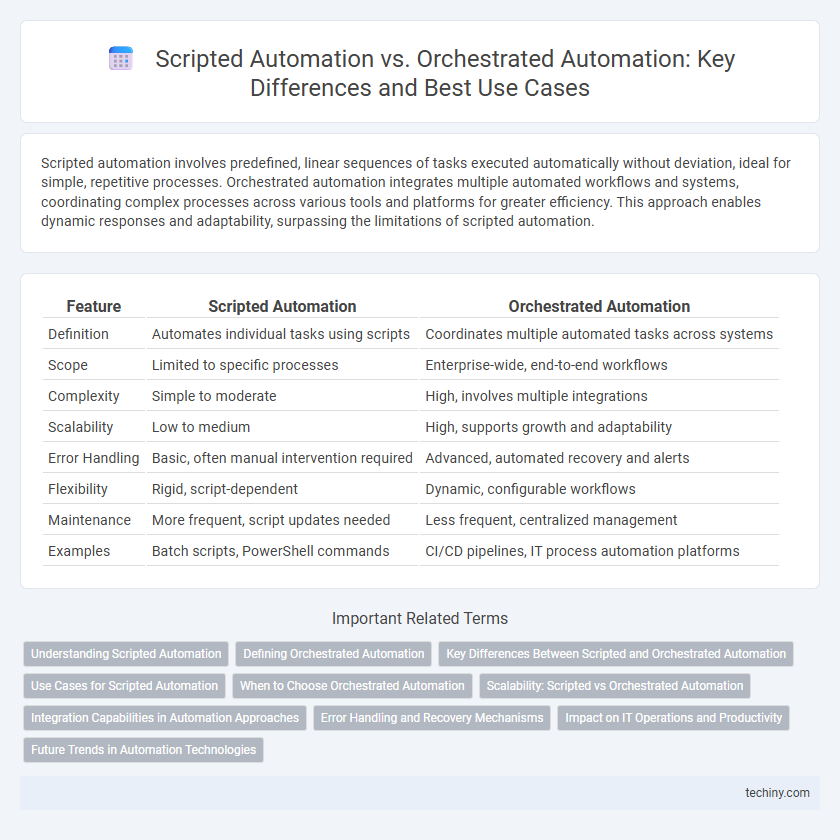Scripted automation involves predefined, linear sequences of tasks executed automatically without deviation, ideal for simple, repetitive processes. Orchestrated automation integrates multiple automated workflows and systems, coordinating complex processes across various tools and platforms for greater efficiency. This approach enables dynamic responses and adaptability, surpassing the limitations of scripted automation.
Table of Comparison
| Feature | Scripted Automation | Orchestrated Automation |
|---|---|---|
| Definition | Automates individual tasks using scripts | Coordinates multiple automated tasks across systems |
| Scope | Limited to specific processes | Enterprise-wide, end-to-end workflows |
| Complexity | Simple to moderate | High, involves multiple integrations |
| Scalability | Low to medium | High, supports growth and adaptability |
| Error Handling | Basic, often manual intervention required | Advanced, automated recovery and alerts |
| Flexibility | Rigid, script-dependent | Dynamic, configurable workflows |
| Maintenance | More frequent, script updates needed | Less frequent, centralized management |
| Examples | Batch scripts, PowerShell commands | CI/CD pipelines, IT process automation platforms |
Understanding Scripted Automation
Scripted automation involves writing specific code or scripts to automate repetitive tasks, offering precise control over individual processes. It is often limited to predefined scenarios and lacks the flexibility to manage complex workflows or integrate multiple systems. Understanding scripted automation is essential for identifying when simple task automation suffices versus when adopting orchestrated automation is necessary for scalable and comprehensive solutions.
Defining Orchestrated Automation
Orchestrated automation integrates multiple automated tasks and workflows across different systems, enabling seamless end-to-end process management. Unlike scripted automation, which executes isolated tasks based on predefined scripts, orchestrated automation coordinates these tasks dynamically to optimize efficiency and reduce manual intervention. This approach leverages centralized control platforms to manage dependencies and ensure smooth execution of complex business processes.
Key Differences Between Scripted and Orchestrated Automation
Scripted automation involves individual, task-specific scripts that perform predefined actions in isolation, limiting scalability and adaptability. Orchestrated automation integrates multiple automated tasks across systems and workflows, enabling centralized management and seamless coordination. The key differences lie in orchestration's ability to streamline complex processes with real-time monitoring, error handling, and dynamic decision-making compared to the static, linear nature of scripted automation.
Use Cases for Scripted Automation
Scripted automation excels in repetitive, well-defined tasks such as data entry, file manipulation, and simple batch processing, delivering quick efficiency gains with minimal setup. It suits environments where processes are stable and changes are infrequent, enabling IT teams to automate routine system checks, log parsing, and scheduled backups reliably. These use cases highlight its strength in task-level automation without the complexity of workflow integration needed in orchestrated solutions.
When to Choose Orchestrated Automation
Orchestrated automation is ideal when managing complex workflows that involve multiple systems, applications, and teams requiring coordinated execution. Choose orchestrated automation to enhance scalability, improve cross-department collaboration, and ensure seamless integration of diverse automated tasks. This approach significantly reduces manual intervention and error rates in enterprise-level IT operations and business processes.
Scalability: Scripted vs Orchestrated Automation
Scripted automation offers limited scalability as it typically handles specific, isolated tasks requiring manual updates for each change. Orchestrated automation provides enhanced scalability by integrating multiple automated processes into a cohesive workflow, enabling dynamic adjustment and expansion across complex IT environments. This scalability advantage reduces operational overhead and accelerates the deployment of end-to-end automated solutions.
Integration Capabilities in Automation Approaches
Scripted automation relies on predefined scripts executed for specific tasks, offering limited integration capabilities primarily through fixed APIs or command-line interfaces. Orchestrated automation enhances integration by coordinating multiple automated processes and tools across diverse platforms, enabling seamless communication and data exchange through advanced connectors and APIs. This approach supports dynamic workflow management, scalability, and end-to-end automation across complex IT environments.
Error Handling and Recovery Mechanisms
Scripted automation often lacks robust error handling and recovery mechanisms, relying on predefined instructions that may fail without adaptive responses. Orchestrated automation incorporates advanced error detection, automatic retries, and fallback processes to ensure continuous operation and minimize downtime. Enhanced fault tolerance in orchestration frameworks improves resilience across complex, multi-step workflows.
Impact on IT Operations and Productivity
Scripted automation streamlines repetitive IT tasks by executing predefined code sequences, reducing manual errors and freeing staff for higher-value activities. Orchestrated automation integrates multiple automated workflows across diverse systems, enhancing coordination, accelerating incident resolution, and improving resource utilization. The combined implementation elevates IT operations efficiency and boosts overall productivity by minimizing downtime and enabling proactive management.
Future Trends in Automation Technologies
Scripted automation relies on predefined sequences of actions tailored for specific tasks, offering quick deployment but limited scalability. Orchestrated automation integrates multiple automated processes and systems, enabling dynamic workflows with enhanced flexibility and real-time decision-making. Future trends emphasize AI-driven orchestration platforms that leverage machine learning and predictive analytics to optimize complex automation ecosystems across industries.
Scripted Automation vs Orchestrated Automation Infographic

 techiny.com
techiny.com